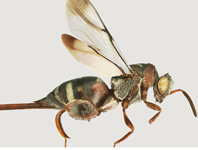Abstract
The genus Antodice Thomson, 1864 was revised by Martins & Galileo (1998) and currently includes 27 species (Tavakilian & Chevillotte 2017), distributed from Mexico to southern South America. Based on a single female specimen collected in Arroyo Cristal, Ka'azapá, Paraguay, the species Antodice quadrimaculata was first described by Martins & Galileo in 2003. The holotype specimen was collected on 20 November 1999 by J. Jensen and is deposited in the Museum of Zoology of the University of São Paulo, Brazil. With the help of Carlos Aguilar, from Paraguay’s National Museum of Natural History, we were able to determine the exact location where the holotype was collected. With the collection and the description of the male, presented herein, we describe the male of this species record its occurrence in Brazil, a new country record.We identified this species as belonging to the group of Antodice species with yellowish flagellomeres and a black apex, resembling Antodice venustula Lane, 1973 in its elytral color pattern. In A. venustula, the elytra are covered with whitish pubescence and exhibit only two patches of compact white pubescence. In A. quadrimaculata, according to Martins & Galileo (2003), the elytra are of a reddish color with whitish pubescence on the dorsal anterior area and close to the apexes, and they also have three patches of compact white pubescence. The specimens of A. quadrimaculata cited herein were collected in the Iguaçu National Park (Parque Nacional do Iguaçu—PNI), the largest fragment of Atlantic forest in southern Brazil, located in the western region of the state of Paraná. The insects were collected using light traps, set up on nights with a new moon. The artificial light source was a 500-Watt incandescent lamp powered by a Honda EP 2500 generator. Sampling began at 6 p.m., ending between midnight and 3 a.m. the next day. The studied material was deposited in the entomological collection of the Museum of Zoology at the State University of Londrina (Universidade Estadual de Londrina), Londrina, Brazil (MZUEL). To better represent the expansion of the geographical distribution of the species from the holotype recorded in Paraguay (Fig. 5, 6), the cartographic material (Fig. 1) was produced using ArcGIS Software 9.0®. The map database was obtained from the Institute of Land, Cartography and Geosciences, (Instituto de Terras, Cartografia e Geologia do Paraná), Curitiba, Brazil (ITCG).
References
Martins, U.R. & Galileo, M.H.M. (1998) Revisão da tribo Aerenicini Lacordaire, 1872 (Coleoptera, Cerambycidae, Lamiinae). Arquivos e Zoologia, 35 (1), 1–133.
https://doi.org/10.11606/issn.2176-7793.v35i1p1-133Martins, U.R. & Galileo, M.H.M. (2003) Novas espécies e nota sobre Lamiinae (Coleoptera, Cerambycidae) neotropicais da coleção Arriagada, Santiago, Chile. Revista Brasileira de Entomologia, 47 (4), 615–620.
https://doi.org/10.1590/S0085-56262003000400013Tavakilian, G. & Chevillotte, H. (2017) Titan: base de données internationales sur les Cerambycidae ou Longicornes. Version 3.0. Available from: http://titan.gbif.fr/ (accessed 21 December 2017)

